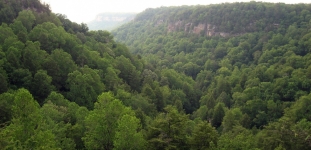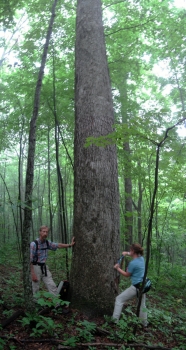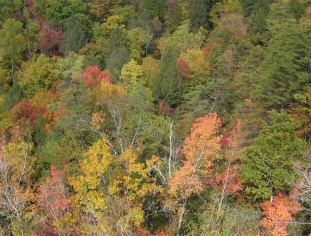You are here
Press Resources: Climate Events Leave Legacy 04/16/14
Press Release: "Study Shows Lasting Effects of Drought in Rainy Eastern U.S."
Scientific paper in Ecological Monographs: "The legacy of episodic climatic events in shaping temperate, broadleaf forests"
Contact: Clarisse Hart, Harvard Forest Outreach Manager, 978-756-6157; hart3@fas.harvard.edu
Photographs
(click image for high-res)
 The rings of old-growth trees - one ring for every year the tree has been alive - can reveal centuries of forest change. Drought often results in very narrow spaces between rings. Photo by Neil Pederson.
The rings of old-growth trees - one ring for every year the tree has been alive - can reveal centuries of forest change. Drought often results in very narrow spaces between rings. Photo by Neil Pederson.
 Kacie Tackett, Troy Evans, Clarissa Cook, and Christine Lattin core an old-growth white oak dating back to the 1660s-1670s in Blanton Forest, Kentucky. It was not until severe droughts and the frost event of 1774 killed the surrounding larger trees, that these oaks were "released" to grow higher into the forest canopy. Today, those oaks are the dominant trees in this old-growth forest. Photo by Neil Pederson.
Kacie Tackett, Troy Evans, Clarissa Cook, and Christine Lattin core an old-growth white oak dating back to the 1660s-1670s in Blanton Forest, Kentucky. It was not until severe droughts and the frost event of 1774 killed the surrounding larger trees, that these oaks were "released" to grow higher into the forest canopy. Today, those oaks are the dominant trees in this old-growth forest. Photo by Neil Pederson.
 An old-growth forest study site in Savage Gulf, Tennessee, composed of ancient chestnut oak, eastern hemlock, and tulip poplars. Data from these trees indicate how quickly these grand and seemingly stable forests can change. Photo by Neil Pederson.
An old-growth forest study site in Savage Gulf, Tennessee, composed of ancient chestnut oak, eastern hemlock, and tulip poplars. Data from these trees indicate how quickly these grand and seemingly stable forests can change. Photo by Neil Pederson.
 Merril Flannary and Bob Gaines extract a core from a large, old-growth white oak in Blanton Forest, Kentucky. Photo by Neil Pederson.
Merril Flannary and Bob Gaines extract a core from a large, old-growth white oak in Blanton Forest, Kentucky. Photo by Neil Pederson.
 Comparing tree ring records like the ones shown here, collected by early anthropologist Florence Hawley, gives insight into the history of a landscape. Photo by Neil Pederson.
Comparing tree ring records like the ones shown here, collected by early anthropologist Florence Hawley, gives insight into the history of a landscape. Photo by Neil Pederson.
 In the old-growth forest of the Watts Creek watershed in Blanton Forest, Kentucky, canopy oak and hemlock are legacies of regional and subcontinental scale dynamics from centuries ago. Photo by Neil Pederson.
In the old-growth forest of the Watts Creek watershed in Blanton Forest, Kentucky, canopy oak and hemlock are legacies of regional and subcontinental scale dynamics from centuries ago. Photo by Neil Pederson.

